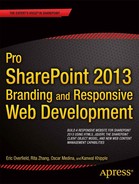Foreword
In just a few short years, we have seen some seismic shifts in how people create and consume content over the Internet. Two fundamental shifts include the meteoric rise of social networking, and the great migration from the dominance of desktop computers to mobile smart phones and tablets. Users now have high expectations for web sites and content to be personalized, interactive, and easily available from any device and form factor. These changes have fundamentally changed the nature of web design and development. As the “Internet of Everything” continues to evolve rapidly, as web designers and developers, we must evolve with it.
With the explosion in browsers, devices, and form factors, we have seen a strong preference across the technology industry for more open and accessible standards for web-based computing. HTML5 has become a rallying point in this movement, both a ubiquitous and continuously evolving set of technologies and standards that will both enable and define the next generation of web sites and applications. It is no surprise that technology vendors, driven by the success of so many open source communities and the demands of customers, have heeded this call. Microsoft is helping lead the way, driving new open standards, and incorporating these standards into the next generation of their servers, applications, development tools, and frameworks.
The release of SharePoint 2013 marks what might be its most important milestone. It is clear that Microsoft has listened to the needs of customers. SharePoint 2013 has introduced must-have features for web content management including improvements in search engine optimization (SEO), multilingual sites, and mobile device support. One of the most significant new changes has been to embrace HTML5 templates as the basis for site designs, rather than the proprietary and SharePoint-specific site design templates that were required in previous versions. All of these new features are covered in-depth through the chapters of this book, but it also provides much more.
Great web sites are not the product of technology alone. SharePoint does provide a robust platform for web sites, but it requires a blend of design and technology carefully crafted by designers to create great user experiences. The authors of this book are recognized SharePoint community leaders, and experts in SharePoint web design and development. In each chapter they walk you through the process of designing web sites using the latest techniques in responsive web design, and demonstrate how to build web sites incorporating essential features of HTML5 and SharePoint 2013. It is their experience and passion for the material that ultimately makes this book so valuable. I hope you enjoy reading it as much as I have.
Chris Beckett
SharePoint Solutions Specialist, Learning Consultant, Author, and Trainer
New Step Learning
Twitter: @sharepointbits
Web site: blog.sharepointbits.com
Email: [email protected]
Seattle, Washington
May 2013
